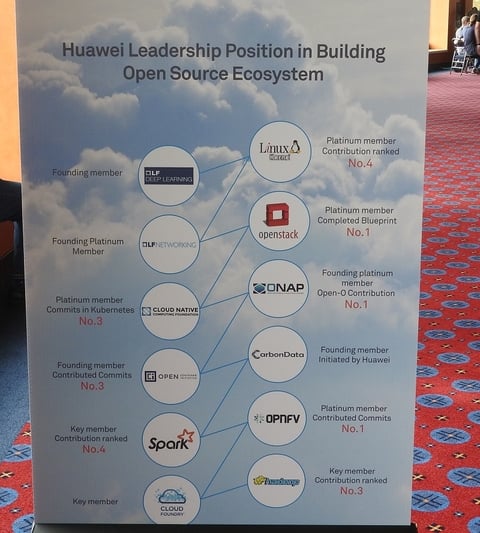PORTLAND, Ore.—For a company that is supposed to be down and out (of the U.S. telecom space), Huawei made a relatively prominent showing at OSCON 2018, where it sponsored a keynote Wednesday morning and made its presence known throughout the convention center’s halls and on the exhibit floor.
Such a showing by Huawei is nothing new. The company has sponsored events and plastered banners at wireless industry events in the past. But the moves are notable given the wrath that Huawei has seen in the nation’s current political climate and heightened scrutiny concerns it continues to get in the telecom space.
RELATED: CCA members look for answers amid U.S. crackdown on Huawei
The FCC this past spring voted to seek comment on a proposal to prohibit use of Universal Service Funds (USF) for the purchase of equipment or services from any company that poses a national security threat to the integrity of U.S. communications networks or the communications supply chain. Huawei, of course, has for a long time been identified by U.S. officials as a potential threat to U.S. security.
The situation is particularly complicated in the wireless industry, in part because the biggest infrastructure vendors are not based in the U.S. and they rely on components that are manufactured in China even if they are based in Europe. In addition, small wireless operators have relied on Huawei for what they consider to be good and cheap equipment. They also may be beneficiaries of the USF.
RELATED: Editor’s Corner—Here are the U.S. wireless carriers currently using Huawei equipment

On Wednesday morning at OSCON, Huawei’s Ying Xiong presented a session on driving innovation and collaboration through open source projects, saying that in all of the open source projects Huawei is involved in, it’s committed to collaboration, whether it’s the Linux Foundation, OpenStack or something else. For open source to be successful, the end user has to be the driving force, he said.
Conference organizers noted that Huawei is very involved in contributing to open source efforts. Plus, there’s a general feeling promoted by the open source community to demonstrate generosity—that’s what open source is all about—and treat others with respect.
“What we see here is they’re trying to be a good open source citizen,” O’Reilly Media's Rachel Roumeliotis, VP, Content Strategy and chair of OSCON, told FierceWirelessTech when asked about Huawei’s involvement in the movement.
RELATED: Huawei: We’re working with HPE. HPE: No, you’re not
Earlier this year, after years of struggling and spending considerable time and effort to boost its business in the U.S., it appeared that Huawei was pulling back from the U.S. market. The company reportedly laid off a chunk of its top U.S. officials, including William Plummer, who had been the voice for Huawei in the U.S.
Of course, Huawei has been a big contributor to the worldwide 3GPP standards-setting process for 5G. In fact, Ericsson, Nokia and Huawei were the top contributors during the 3GPP standardization process going back to the start of Release '99, according to Signals Research Group (SRG).
Based on SRG’s analysis of 3GPP standardization activities dating back to Release 99 and spanning 17 working groups, Ericsson, Nokia and Huawei (in that order) accounted for up to 41% of all technical document submissions submitted to 3GPP for consideration during the standardization process.
